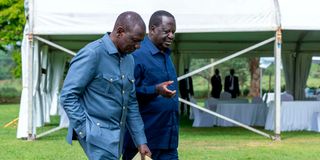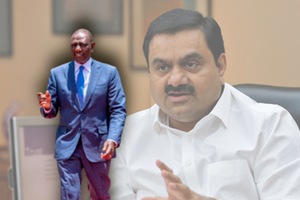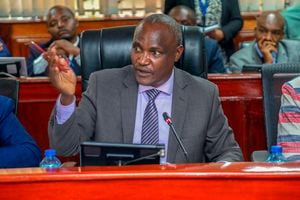
President William Ruto and former Prime Minister Raila Odinga.
It was a dramatic reversal last Thursday when President William Ruto used the State of the Nation address in Parliament to direct cancellation of two of the controversial deals — the Jomo Kenyatta International Airport expansion and the Kenya Electricity Transmission Company power lines — struck with Indian conglomerate, the Adani Group.
While supporters of the system tried to put a positive spin on it as a brave or bold move, it was, in fact, a humiliating capitulation after the President had strongly supported the Adani deals in defiance of unrelenting public pressure over the opaque procurement process which chose to ignore all the red flags about firm’s history.
It is clear that Ruto’s hand was forced by indictment in the United States of the giant corporation’s founder and chairman Gautam Adani and his top executives over a $265 million (Sh34 billion) bribery scheme to secure projects in India.
Ruto’s climb-down on the Adani deals followed hot on the heels of blistering criticism of his leadership delivered by all the mainstream Christian churches, reversing more than two years of relative silence when they were accused of going to bed with the government.
The onslaught was lent an unprecedented bit of drama when the Catholic Church, which started the onslaught, rejected Ruto’s Sh5.6 million donation for various projects.
These dramatic developments, which indicated a president suddenly on the ropes, came just a month a Ruto was acknowledged as master of the political game following the speedy impeachment of Deputy President Rigathi Gachagua and installation of his successor Kithure Kindiki.
After the powerful rebound in which he overcame his sternest political test in the unprecedented revolt in June led by Gen Z movement, it appeared that Ruto had firmly regained the political initiative. He had responded to the Gen Z revolt against high taxation by withdrawing the contentious Finance Bill and dissolving the Cabinet.
Then he incorporated nominees of opposition leader Raila Odinga in a reconstituted government. That left the Azimio la Umoja-One Kenya coalition greatly weakened with the remaining leaders — Kalonzo Musyoka of Wiper Party, Eugene Wamalwa of DAP Kenya and Jeremiah Kioni of former President Uhuru Kenyatta’s wing of the fractured Jubilee Party — badly short of the numbers required to keep government in check inside and outside Parliament.
The strange arrangement where Raila got his party loyalists in strategic and powerful Cabinet posts, notably John Mbadi at the National Treasury and Opiyo Wandayi at Energy, yet his ODM troops retained their official Minority leadership posts in the National Assembly and Senate, was also a boon for Ruto.
His Majority Kenya Kwanza coalition became almost unchallenged in Parliament. The youthful Gen Z movement which just a few weeks had pushed Ruto to the wall and made much more impact than a year of post-election protests by Raila’s forces, were left in the lurch after a brutal security crackdown.
Seemingly untouchable and in full command of the political arena, Ruto then had the courage to go after his estranged Deputy President, Gachagua, who in short order was impeached with support of the Raila brigade.
While ejecting Gachagua meant Ruto losing a large chunk of the populous Mt Kenya vote that had propelled him to the presidency, the presidency probably calculated that acquiring Raila’s support offered adequate compensation as he started cobbling together a new coalition for his 2027 re-election campaign.
In the meantime, he felt emboldened enough to start bringing back the contentious taxation proposals that had ignited the Gen Z protests in the first place, and also ram through a series of widely unpopular projects such as the Social Health Insurance Fund. He also continued to dismiss of faltering policies such the Housing Fund, the revamped education system and the new public university funding model.
Even with clear and growing public discontent over a host of economic factors — high taxation, cost of living, unemployment — as well issues such as rampant corruption and police brutality, Ruto seemed well on his way to achieving untrammeled power with his near absolute control of Parliament and the political arena in general courtesy of having Raila in the pocket.
And then in the blink of an eye, things started unravelling. The first salvo was fired by the Catholic Bishops with a hard-hitting statement pointing out all the unresolved issues since the Gen Z protests.
Kenya Kwanza faithful were mobilised for a series of coordinated counter-offensives, only to be caught napping when other mainstream Christian denomination, including the Anglican Church and the umbrella protestant grouping, the National Council of Churches of Kenya, came out forcefully in support of the Catholic brethren.
While separate government ministries and departments such as Health, Education, Transport and others were tasked to publicly defend their respective corners, it was clear that the government did not have a clear and well-thought-out response to the welter of accusations.
And with the exception of just a handful of politicians who were quick to denounce the Church, it was clear that the usual loud mouthpieces were unusually quiet. They either were not properly mobilised on how to respond, or were left confused after Ruto himself abandoned the obdurate stand and declared that he had heard the Church and was willing to engage.
Then came the US indictment of Adani, which forced Ruto to beat a hasty retreat on projects he had forcefully defended despite public outcry and a large number of red flags. That the right hand did not know what the left hand was doing was provided a powerful example as Ruto directed cancellation of the deals just hours after his Energy Cabinet, Wandayi, had defended the Ketraco contract and insisted it would continue despite the US indictment.
He argued that any corruption which led to the US action was not in relation to the Kenya contract. This led to a memorable riposte from a Kenya Kwanza Senator, Boni Khalwale, who wondered if one would welcome a known child rapist into his house on the basis that the offenses were committed elsewhere.
If Wandayi was hung out to dry on the Adani reversal, it might seem that Raila’s surrogates in the Cabinet, notably Mbadi at Treasury, were handled poisoned chalices. If there is to be the natural sequence of events following the cancellation, it should mean that Ruto institutes a probe on how the Adani deals passed muster despite all the warning signs.
On the spot will obviously be Wandayi and his predecessor, Davis Chirchir, currently CS for Roads and Transport. Energy Principal Secretary Alex Kamau Wachira and Ketraco Managing Director John Mativo will also have questions to answer.
Also in the spotlight will be Treasury CS Mbadi, together with his predecessor Njuguna Ndung’u, and the Principal Secretary Chris Kiptoo. No contracts of such nature can go through without concurrence of the Treasury. The office of Attorney-General could also be on spot of deemed to have approved the contracts.
AG Dorcas Oduor is another newcomer with installation of the broad-based government, but might will have to answer a few questions, as well as her predecessor Justin Muturi, currently the CS for Public Service.
Solicitor-General Shadrack Mose, who is reputed to enjoy the presidents ear sometimes to exclusion of the AG, might also be required to provide information on how the contracts were approved.
During his tenure, Muturi often complained that some government ministries and departments, and even State corporations, were getting into contractual obligations without seeking approval of the AG as required by law.
Chirchir could also be on the spot over Adani airport deal, as well as his predecessor at Roads and Transport Kipchumba Murkomen, presently the CS for Youth Affairs and Sports. Others would be the PS for Transport Mohamed Daghar, as well top officials of the Kenya Airports Authority, including Board chairman Caleb Kositany, a close Ruto ally, acting CEO Henry Ogoye.
A competent and independent probe would probably not leave State House untouched. There is growing evidence that many of the major projects pushed by the Ruto regime actually emanate from the seat of power, from where the limen ministries are directed to implement with little regard to procurement rules. The Adani deals are no exception.
It also remains to be seen how in the light of corruption allegations and cancellation JKIA and power transmission lines projects, the Sh104 billion Social Health Authority-Social Health Insurance Fund technology platform deal will proceed.
While continuing to support the universal health cover scheme, Ruto did not mention that one of the largest partners in the technology consortium, Apeiro Limited, is reported to be linked to the Adani Group.
Safaricom, Kenya top mobile phone provider that was roped into the consortium as lead technology partner, might also start to look askance at what it has gotten itself into in light of the US indictment of Adani.
Then there are the political ramifications. The Churches powerful message to Ruto was a stark reminder that he is as impregnable as he might assume. The message was well received by a populace that has been muted since the Gen Z revolt was crushed, but will now be emboldened to start speaking out.
The Church statements will act as a catalyst for the Gen Z movement, which abandoned street protests but retreated to intensive civic education in universities, youth movements, churches and other groupings, to come out again.
Indeed, there is likelihood in coming weeks that there will be a resurgence of civil disobedience campaigns that bring together a consortium of Gen Z, religious groupings, civil society, trade unions, student groups, academia, professional associations, business lobbies and others keen to come out with powerful indictments of the system.
If that happens, then many of the political groupings sensing the mood will most likely join in. The remaining Azimio leadership under Kalonzo will be keen to join such a push, as well as allies of Gachagua. Even some of Raila’s ODM troops uncomfortable with being used to prop up Ruto and do his dirty work might start to abandon ship.
Raila already has egg on his face after having publicly supported the Adani deals. It was not lost on him the protesting churches included a group of clergymen form his Nyanza political bastion, who while criticising Ruto made a point of emphasising that establishment of the broad-based amounted to ‘commercialisation’ of politics, and had led to silencing of opposition voices in their region.
The implied criticism of Raila was accompanied by a threat to call for public demonstrations and a tax boycott.












